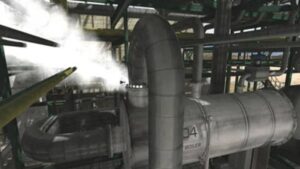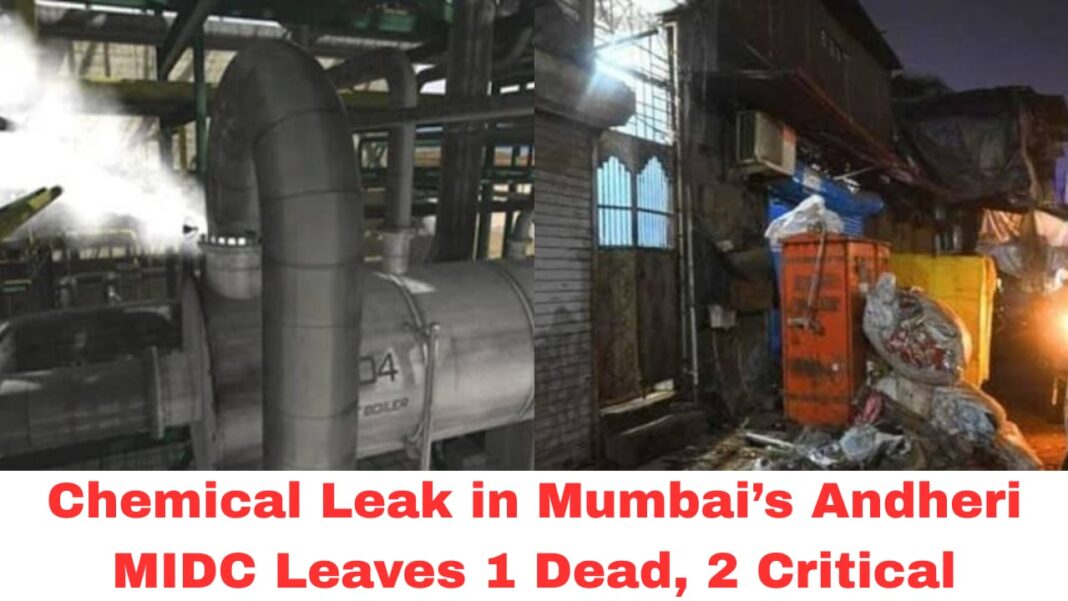Digital News Guru Mumbai Desk:
Tragedy in Andheri: Chemical Leak Claims One Life, Two Hospitalised in Mumbai Industrial Zone
A grim incident unfolded on Saturday evening in Mumbai’s Andheri (East) industrial area, where a sudden chemical leak in a small industrial structure led to the death of a 20-year-old and left two others in critical condition. The leak, which took place in the Bhangarwadi area of the Maharashtra Industrial Development Corporation (MIDC) estate, has set off alarm bells about industrial safety protocols and emergency preparedness.
The Incident
According to fire officials, the distress call came in around 4:55 pm. The leak was reported from a modest two-storey (ground + one) industrial building in Bhangarwadi, a region dotted with small to medium-scale manufacturing units. Those inside the structure began collapsing, apparently after inhaling toxic fumes from an “unknown chemical,” as described by authorities.

Fire-brigade teams rushed to the site immediately. Their priority was to contain the leak and conduct a search operation, trying to locate the exact source. Meanwhile, given the uncertainty around the nature of the chemical, the National Disaster Response Force (NDRF) was placed on alert to assist in case specialized decontamination or further containment was required.
The Victims
Tragically, one of the three people affected could not be saved. The deceased has been identified as Ahmad Hussain, aged 20. He was declared “brought dead” on arrival at Holy Spirit Hospital, where the other two — Naushad Ansari, 28, and Saba Shaikh, 17 — are currently battling for life in the intensive care unit.
Their condition is critical, and reports suggest that their breathing was severely compromised due to exposure to the chemical fumes.
Response and Investigation
The Mumbai Fire Brigade’s rapid response was complemented by search crews scouring the building to trace the leak’s origin. Authorities have yet to identify the exact chemical involved, which complicates the containment and treatment strategy.
The area around the building has been cordoned off to prevent further exposure. According to reports, locals were advised to keep windows closed and avoid the immediate vicinity as authorities monitored air quality.
Officials from the Brihanmumbai Municipal Corporation (BMC), along with teams from the MIDC-area police station, are coordinating the on-site operation.
Concerns and Root Causes
This incident underscores several deep-seated concerns about industrial safety in Mumbai:
- Lack of Clarity on Hazardous Substances: The fact that the chemical is still unidentified raises serious questions. Without knowing what leaked, it’s difficult to assess both the immediate risk and longer-term health implications for first responders and nearby residents.
- Safety Protocols: Small industrial units, like the one in question, may lack robust safety mechanisms, effective ventilation, or proper chemical-handling protocols. The collapse of three individuals suggests that either the leak was sudden and severe, or that preventive safeguards were inadequate.
- Industrial–Residential Proximity: MIDC estates such as Andheri are often in close proximity to dense urban settlements. Accidents in such locales can have repercussions that go beyond factory workers, affecting local residents and bystanders.
- Emergency Preparedness: While the NDRF’s involvement indicates seriousness, such incidents demand pre-emptive risk management. Are there regular drills, chemical-risk assessments, or community-awareness programs in place?
Broader Context
This is not the first time that a gas or chemical leak has occurred in or around Mumbai’s industrial zones. For instance, in 2022, a toxic gas leak from a chemical unit in Kurla Industrial Estate claimed one life and left others hospitalised. Such repeated incidents highlight systemic vulnerabilities in industrial safety governance.
Experts argue that stricter oversight by pollution control and industrial safety agencies is needed. Training for workers, mandatory reporting of hazardous materials, and regular audits could help prevent such tragedies.
Human Cost
The human cost of this incident is deeply saddening. Ahmed Hussain, at just 20 years old, lost his life doing what may have been routine work. The other two, including a teenager, are fighting for their lives. Their families are likely in shock, grappling with grief, fear, and uncertainty. The hospital environment, the critical care, and the slow process of recovery are all heavy burdens emotionally, financially, and psychologically.
Regulatory and Social Accountability
This accident will inevitably trigger scrutiny of regulatory frameworks. Industrial units are required to follow safety standards, but enforcement remains a challenge. Who will be held accountable? Will there be a formal inquiry by the Maharashtra Pollution Control Board (MPCB) or other industrial safety bodies? Will the owners of the unit face legal or regulatory penalties?
Furthermore, there’s a social question: what is the right balance between industrial development and worker safety? Mumbai’s economic engine depends heavily on its industrial zones. But prosperity should not come at the cost of lives.

Moving Forward
Some immediate steps that could be taken:
- Complete Chemical Analysis: Identifying the exact chemical will help determine the risk, guide medical treatment, and inform long-term health monitoring.
- Strengthen Industrial Safety Audits: Regulatory bodies like the MPCB should accelerate unannounced safety visits, especially in older or smaller units.
- Worker Training and Equipment: Ensuring that workers have protective gear, ventilation equipment, and emergency-response training is critical.
- Community Engagement: Local authorities should engage with nearby residents, educating them about potential hazards and disaster protocols.
- Emergency Infrastructure: Enhance coordination between fire services, NDRF, hospitals, and industrial units so that future incidents can be responded to more swiftly.
Conclusion
The chemical leak in Andheri is a stark reminder of the potential perils that accompany industrial growth. While economic zones generate employment and growth, they also carry risks—especially when hazardous substances are involved. The death of Ahmad Hussain, and the serious condition of Naushad Ansari and Saba Shaikh, highlight the very real human consequences of industrial accidents.
For Mumbai — a city that lives on the edge, where residential neighbourhoods often butt up against factories — strengthening industrial safety is not just a regulatory need but a moral imperative. The response to this tragedy, and the steps taken to prevent future ones, will test the city’s commitment to safeguarding its workers and its people.
You May Also Read: India’s Major Trade Unions Slam New Labour Codes as Anti-Worker, Pro-Employer









